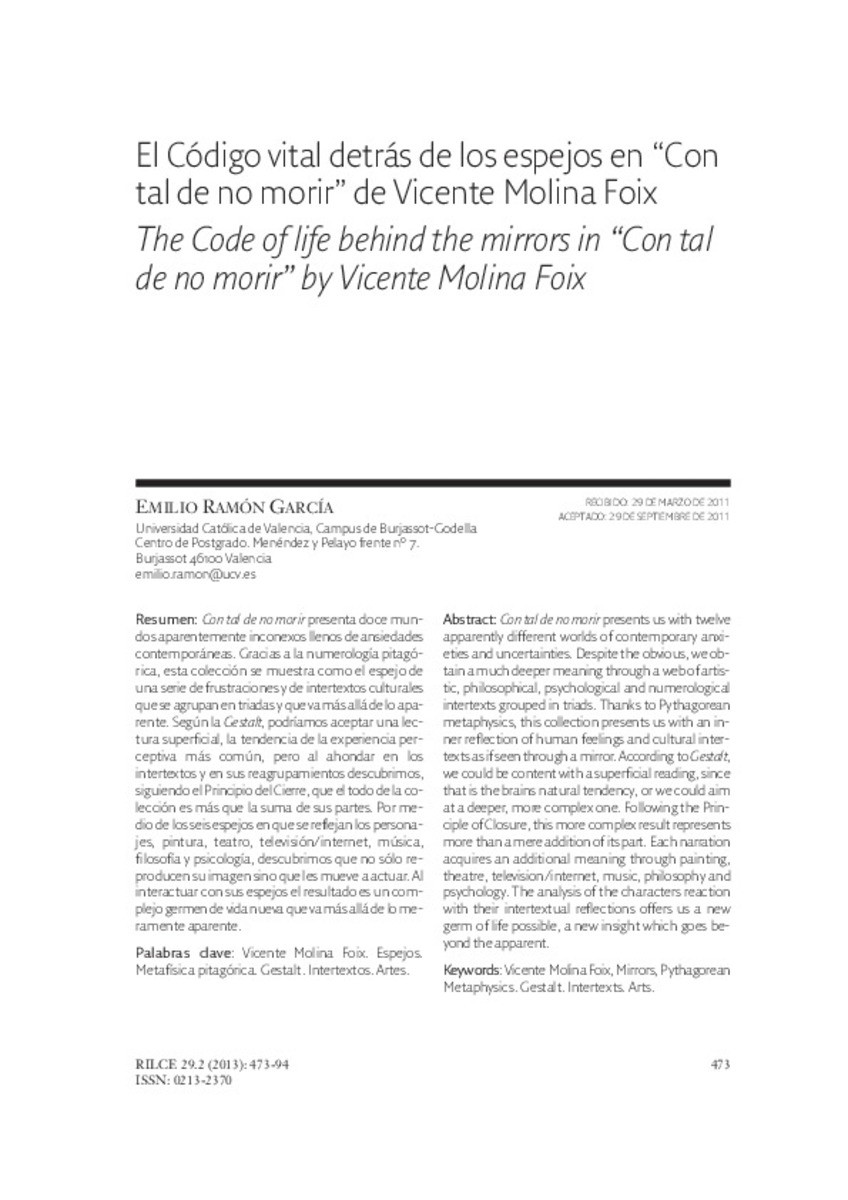Full metadata record
| DC Field | Value | Language |
|---|---|---|
| dc.creator | Ramón-García, E. (Emilio) | - |
| dc.date.accessioned | 2014-10-27T12:18:59Z | - |
| dc.date.available | 2014-10-27T12:18:59Z | - |
| dc.date.issued | 2013 | - |
| dc.identifier.citation | Ramón-García, E. (2013). ""El Código vital detrás de los espejos en “Con tal de no morir” de Vicente Molina Foix"", Rilce, vol. 29, n.2, pp. 473-494. | es_ES |
| dc.identifier.issn | 0213-2370 | - |
| dc.identifier.uri | https://hdl.handle.net/10171/36937 | - |
| dc.description.abstract | Con tal de no morir presenta doce mundos aparentemente inconexos llenos de ansiedades contemporáneas. Gracias a la numerología pitagórica, esta colección se muestra como el espejo de una serie de frustraciones y de intertextos culturales que se agrupan en triadas y que va más allá de lo aparente. Según la Gestalt, podríamos aceptar una lectura superficial, la tendencia de la experiencia perceptiva más común, pero al ahondar en los intertextos y en sus reagrupamientos descubrimos, siguiendo el Principio del Cierre, que el todo de la colección es más que la suma de sus partes. Por medio de los seis espejos en que se reflejan los personajes, pintura, teatro, televisión/internet, música, filosofía y psicología, descubrimos que no sólo reproducen su imagen sino que les mueve a actuar. Al interactuar con sus espejos el resultado es un complejo germen de vida nueva que va más allá de lo meramente aparente. | es_ES |
| dc.description.abstract | Con tal de no morir presents us with twelve apparently different worlds of contemporary anxieties and uncertainties. Despite the obvious, we obtain a much deeper meaning through a web of artistic, philosophical, psychological and numerological intertexts grouped in triads. Thanks to Pythagorean metaphysics, this collection presents us with an inner reflection of human feelings and cultural intertexts as if seen through a mirror. According to Gestalt, we could be content with a superficial reading, since that is the brains natural tendency, or we could aim at a deeper, more complex one. Following the Principle of Closure, this more complex result represents more than a mere addition of its part. Each narration acquires an additional meaning through painting, theatre, television/internet, music, philosophy and psychology. The analysis of the characters reaction with their intertextual reflections offers us a new germ of life possible, a new insight which goes beyond the apparent. | es_ES |
| dc.language.iso | spa | es_ES |
| dc.publisher | Servicio de Publicaciones de la Universidad de Navarra | es_ES |
| dc.rights | info:eu-repo/semantics/openAccess | es_ES |
| dc.subject | Vicente Molina Foix | es_ES |
| dc.subject | Espejos | es_ES |
| dc.subject | Metafísica pitagórica | es_ES |
| dc.subject | Gestalt | es_ES |
| dc.subject | Intertextos | es_ES |
| dc.subject | Artes | es_ES |
| dc.subject | Mirrors | es_ES |
| dc.subject | Pythagorean Metaphysics | es_ES |
| dc.subject | Gestalt | es_ES |
| dc.subject | Intertexts | es_ES |
| dc.subject | Arts | es_ES |
| dc.title | El Código vital detrás de los espejos en “Con tal de no morir” de Vicente Molina Foix | es_ES |
| dc.title.alternative | The Code of life behind the mirrors in “Con tal de no morir” by Vicente Molina Foix | es_ES |
| dc.type | info:eu-repo/semantics/article | es_ES |
| dc.relation.publisherversion | https://revistas.unav.edu/index.php/rilce/index | es_ES |
| dc.identifier.doi | 10.15581/008.29.2897 | es_ES |
Files in This Item:
Statistics and impact
Items in Dadun are protected by copyright, with all rights reserved, unless otherwise indicated.






